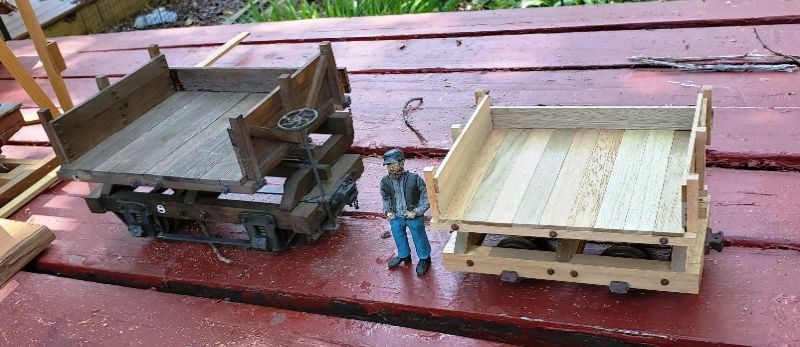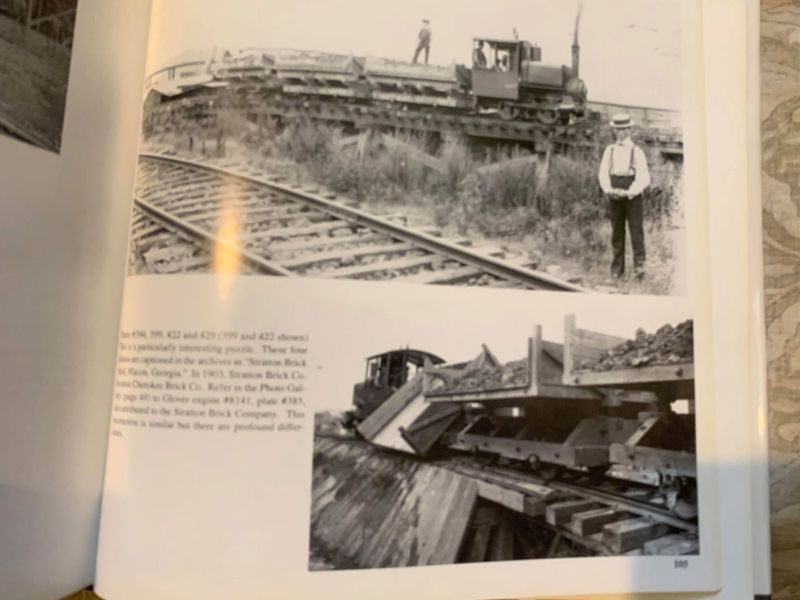Here we have a pair of “ore” cars, one in 7/8ths scale, the other 1:20.3. I hae never seen a photo of the prototypes in use and carrying ‘ore’. What did they carry? Gold ore in Colorado? Bricks? Anyone know where I can find some prototype photos?

Here we have a pair of “ore” cars, one in 7/8ths scale, the other 1:20.3. I hae never seen a photo of the prototypes in use and carrying ‘ore’. What did they carry? Gold ore in Colorado? Bricks? Anyone know where I can find some prototype photos?

Pete;
I think I saw similar cars in the old film footage concerning the building of the Panama Canal. They probably did not have to travel far before they got dumped. Probably just held one scoop from a steam shovel. Not sure whether your models are of cars that actually hauled ore or overburden. Either way, they were not sent very far. Elsewise, the load would have shaken off the low side and be gone.
Regards, David Meashey
Keep in mind Pete that there were plenty of locally built stuff as well. Local carpenters and blacksmiths were pretty creative at copying an idea
I think that the qestion to be asking is; where was this style car developed and who built them. With that information the, what were they hauling, would be easily answered.
Can I contribute any solid information to answer your question, no. But I think the answer still lies in where the cars were develooped.
Hope we find the answers as they are really neat cars and I would like to know more about them.
One maker of these types of cars was Western Wheel Scraper.
Back issues of NG&SLG have plans for some of these cars.
Typically there was a mechanism to lift the side boards and tip the car to one side or another.
These were typically used in railroad construction.
Either way, they were not sent very far. Elsewise, the load would have shaken off the low side and be gone.
That was my feeling.
Typically there was a mechanism to lift the side boards and tip the car to one side or another.
No expert but is this it? [link]
If so then iron ore…
Al, Jim - these don’t have a side board to hold things in place. (The Bachmann Tippers do, so I left them out.)
The manufacturer (Richard Finlayson, aka Trail Creek Models,) labelled them “Stratton Brick Co. Side Dump Ore Cars”. I found a Stratton mentioned in the Cripple Creek/Victorville gold mining area of Colorado, but no pictures yet of these cars carrying a load. There was also a Stratton Brick Co in Georgia, so the cars might have carried bricks?
https://www.loc.gov/resource/g4314cm.g009811894/?sp=1&r=0.103,0.282,1.11,0.441,0
Just saying ?
Now dig in and get busy as research is part of the hobby !
Page 8 and 9 tell the truth ! Exactly why 6 is afraid of 7 because 789 but there is always a 10 yummy!
The cars being tippers and if used in the brick business they probably carried raw material, clay, sand, etc to the plant rather than finished bricks from the plant.
BTW …Only mine I was ever involved with apparently turned into a gulch. But the Sanborne maps don’t lie !
Rick Marty said:
The cars being tippers and if used in the brick business they probably carried raw material, clay, sand, etc to the plant rather than finished bricks from the plant.
That’s what I’m thinking. a brick works would be moving clay to the plant and that’s a dense material that would likely stay put in an open car.
Rooster said:
Page 8 and 9 tell the truth ! Exactly why 6 is afraid of 7 because 789 but there is always a 10 yummy!
Researching what you said in your posts is almost as complex as the history. I did find several references to a Mr Stratton in the mining docs for Cripple Creek - I think he owned the “Independence” mine on page 9.
But I am currently thinking brick works in Georgia.
I finally got a response from Richard F, who made the kits 20+ years ago. He confirmed the inspiration came from Stratton Brick Co, of Macon, Geargia, and sent this pic from his Glover Locomotives book:

A bit more research (right, Rooster?,) and I found the Cherkee Brick Co History page:
https://www.cherokeebrick.com/the-history-of-cherokee-brick/
Cherokee bought Stratton in 1903. Both these 2 photos from the book are on this History page. The caption for the second, tipping car pic, says:
“Cyrus Chambers, one of the visionaries and inventors of modern brick making, postulated that large scale brick making operations could succeed in the machine age using steam shovels to dig clay, rails to transport the earth and dump it into large hoppers at the machine house, where screening, mixing, tempering, molding, drying, and burning could occur with the clay never being touched by human hands. Through Chambers and 39 inventive genius and that of countless other inventors, new equipment emerged that permitted brick makers to dramatically increase production”
So the loads were, as suspected, clay and other brick ingredients. Heavy, dense material. My problem is/was that they are labelled "Stratton Brick Ore Cars, when in fact they are clay carriers!
Good find Pete. It is always satisfying when you get that “There it is, finally” moment when researching a project.
Pete- We can dig down in my garden and find all the clay you need!
Jerry
Jerry Bohlander said:
Pete- We can dig down in my garden and find all the clay you need!
Jerry
I was wondering how to “model” a load of clay. I can weather the cars with dark grey/brown/black but what to put on them. Slop a wet mix of real clay with a few little rocks in it? Guess we’ll have to experiment.
https://www.loc.gov/resource/g3924mm.g3924mm_g014681908/?sp=107&r=-0.105,0.745,1.099,0.437,0
Thank you for the history !
Plasticine makes a good clay substitute. Cleaner and also has many modelling uses as I guess you know Pete. It is some while since I used it but I believe there is choice of color.